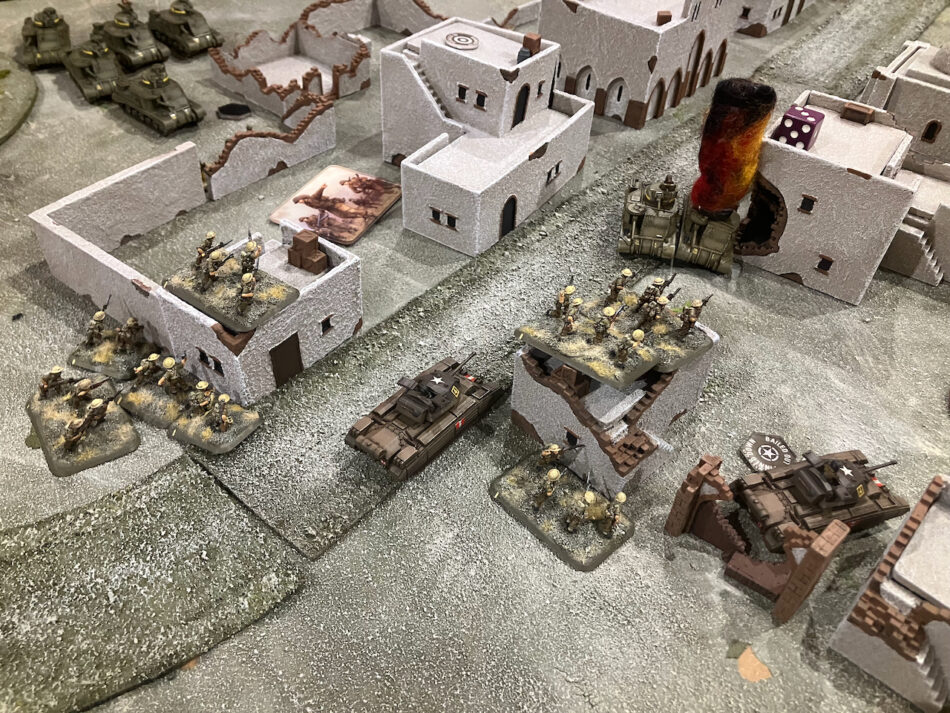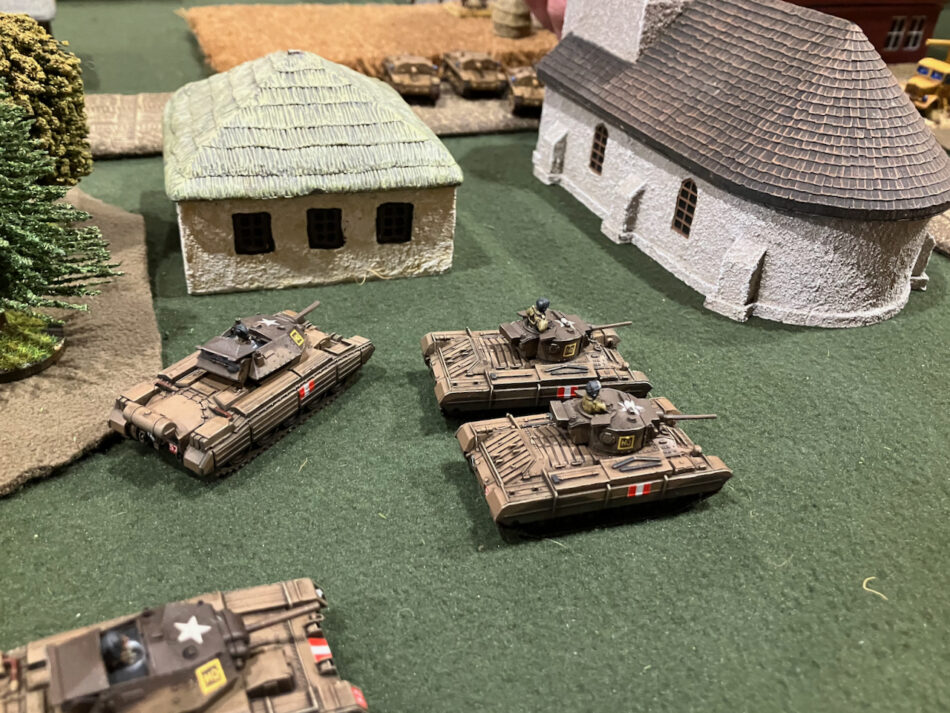Death or Glory: Flames of War at ValleyCon 2024
By Richard Steer
Every year, the Hutt Miniature Wargames Club hosts the ValleyCon wargaming event in Upper Hutt, New Zealand. 2024 was the club’s 25th anniversary, and fittingly, ValleyCon 2024 was its biggest event yet. 170 gamers came together from across New Zealand to spend two days playing in tournaments for eight gaming systems.
I played in the Flames of War tournament, which had 20 players with 98-point Mid-War lists using Dynamic Points in five 2.5-hour rounds. I try to bring a new army to each ValleyCon, and 2024 was the year that I finally built a British ‘Death or Glory’ Armoured Squadron.

Building My List
The ‘Death or Glory’ list is based on the British 6th Armoured Division from the time it landed in Algeria in November 1942 until their Valentine and Crusader tanks were replaced with Shermans in March 1943.
The starting point for my list was a build that expanded upon the British Crusader Armoured Squadron boxed set. The concept was that by adding a box of Valentines, a Rifle Platoon, and some armored cars to the starter set, I could create a well-rounded force with plenty of anti-tank weapons, that would be able to handle a wide range of missions and opponents.
The Mid-War Dynamic Points for 2024 doubled the cost of armored cars, so my original plan of pairing the Death or Glory Squadron with a minimum-sized Mailed Fist Armoured Car Squadron wasn’t going to fit within the 98-pt limit for the event. However, by scaling the armored cars back to a single troop of three Humbers, I was able to field a full squadron of eight Valentine 2pdrs, six Crusader 6pdrs, and two Crusader CS, supported by four 25pdr field guns, a Rifle Platoon, and the Humbers.
My force was rounded out with the largest number of Command Cards I’ve ever used: Cavalry Commander improved the tanks’ mobility, Death or Glory increased their Last Stand morale, PIAT and Sticky Bombs gave the infantry the tools they needed to deal with tanks on their own, and Artillery Expert and Diversionary Tactics increased the effectiveness of my artillery while reducing the chance of enemy artillery influencing my deployment. My final point was spent on a Lucky card.

My plan for the event was to use the Manouvre stance as much as possible. Attack has always been the most popular stance for tanks, but the Battle Plans mission selector recommends Manoeuvre for mobile forces, and I was determined to test that advice. After my usual last-minute rush to get everything painted, it was time to see whether the theory worked in practice.

Game 1 – Scouts Out
My first game was against an Italian Heavy Tank Company of long-barreled Semoventes. We both chose to Manoeuvre, and rolled up Scouts Out.
The problem with choosing Manoeuvre with my force immediately became apparent. To get to the required maximum of 58-pts on-table, I had to place four units in Delayed Reserve, including most of my tanks. My opponent attacked me hard and fast, trying to carry the front objective before those reserves could arrive.

Fortunately, I had just enough time to get my infantry into a wood from where they could contest my front objective. The Semoventes could not assault them out, and the objective was covered by my dug-in 25pdrs. Once my reserves started arriving, the sheer weight of mobile firepower I could lay down against his lightly armored tanks started to tell, giving me an 8-1 victory when his formation broke.

Game 2
My second game was against a US Sherman Company, supported by a Ranger Platoon. This was altogether a different challenge to my previous game, as I was now facing lots of good armor and Anti-tank 10. Deviating from my plan for the weekend, I chose to Attack in order to start with as much of my force on-table as possible. My opponent chose to Manoeuvre, and we rolled up Breakthrough with me as the attacker.
The front objective was in a town, defended by the Rangers and two Lees. My plan focused on getting my infantry into the town, and clearing it with support from my tanks and artillery.

I sent a troop of Crusaders around the left side of the town. It was glorious and futile, because they ran headlong into a platoon of five Lees arriving from reserve. I really can’t explain why I did this – they would have achieved far more by being in my Flanking Reserves and arriving directly on the back objective.
As it was, my focus on starting with all my tanks on the table meant my reserves were just the Humbers. These were simply not powerful enough to trouble the Stuart platoon holding the rear objective, leaving the Lees and Shermans free to focus on my main effort.

My infantry reached the town on Turn 2 and successfully assaulted the Rangers to gain a foothold. They continued to press forward in Turn 3, but by then most of my armor had been shot away by the Lees and Shermans, and were unable to clear the objective before my formation broke for an 8-1 loss.

Game 3
The final game of day one was against an Afrika Korps infantry company with Marders and lots of PaK38s. I was expecting my opponent to Defend, so I chose Manoeuvre to avoid having to deal with minefields. This proved to be correct, and I was the attacker in Cornered.

This was a brutal game for the defender. Two troops of tanks used the Humbers’ Spearhead and the Follow Me movement order to drive deep towards the back objective, drawing out the Marder ambush near the back edge of the table where they couldn’t influence the game. The combined weight of tank and artillery fire set up an infantry assault that cleared the front objective in Turn 4 for an 8-1 win.

Game 4
Day two brought a new challenge: facing a Brummbar Company supported by a Ferdinand and a platoon of Panzer I Fs. This was a lot of heavy armor, and I regretted coming to the event with my only weapon greater than Anti-tank 9 being a single PIAT. I chose to Manoeuvre again, while my opponent picked Attack, leading to me defending in Contact.

My Crusaders died early trying to kill Brummbars on the left flank. The Ferdinand rumbled on from reserve and drove straight down the table onto the objective on my right, with nothing I had able to hurt it. I stacked that objective with my armored cars and HQ troop, in the hope that the Ferdinand wouldn’t be able to kill them fast enough to win the game there.
A high point was the Panzer Is assaulting my infantry in the woods, allowing me to play my Sticky Bombs card for the first time. By the time the assault was over I had killed three of them, with the fourth failing its Last Stand, breaking the platoon.

I managed to get two Valentines back across the table to drive his Grenadier platoon off an objective. I won the assault but was engaged at extreme range by an 88, leaving me with just one bailed Valentine on the objective. The game came down to two dice rolls: a 4+ Remount, and a 2+ Last Stand for that platoon which would have broken my formation. I passed both for a 6-3 win.

Game 5
My final game was on the same table as the previous one, this time against Afrika Korps Panzer IIIs supported by a Tiger. This put me in the same position as the last game, of not being able to kill a key piece of my opponent’s force. I chose Manoeuvre again, while my opponent chose Attack, resulting in me defending in Counterattack.

Faced with the same problem of an unkillable tank sitting on an objective, I adopted the same approach of swarming the open objective to stop the Tiger from capturing it, while I hunted down the Panzer IIIs with Valentines. The last Panzer was gunned down by defensive fire in a desperate assault against my last 25pdr on my back objective, breaking his formation and giving me an 8-1 win.

Reflections
I finished the five rounds with 31 points, giving me 2nd place in the standings. The event was won by Sofia Chambers with an Italian force built around infantry and Semoventes.
The tournament had a good mix of nations and list types, with six British, six German, four American, and three Italian forces, but only one Soviet list (Lend-Lease Lees). Most players brought tank formations, but Dynamic Points pushed this towards medium rather than light tanks, with lots of Shermans, Lees, and Panzer IIIs in evidence., and significantly fewer Stuarts, Crusaders, and armored cars than in previous Mid-War tournaments I’ve played in.
All Mid-War Monsters were permitted except the KV-5, but those that were used didn’t seem to dominate their games. We saw Semovente 90s, long-barreled Semovente 75s, Panzer Is, and a pair of TOGs.
The Manoeuvre stance worked well for me. In my last two games, it placed me as the defender against an opponent who had chosen to Attack. This forced them to push forward, towards an objective that was anchored by a strong infantry platoon and four 25pdrs. Once they got close, the speed of my tanks, boosted by the Cavalry Commander card, gave me lots of opportunities for side shots, reducing the downside of the Valentines’ low Anti-tank rating.
It was an excellent weekend, playing some enjoyable games with a great group of people. I’m already looking forward to next year, and the chance to explore something new to take to ValleyCon 2025.


Can’t you still take the 6th Armoured Divs own A/C Regiment 1st Derbyshire Yeomanry as support in V4 ?
I couldn’t see a way to do it short of taking them as a second formation, because they aren’t in the Support tree and Page 12 of LFTF says you can’t take Formation Support from a Command Card formation. But even the official Mailed Fist Troop wouldn’t be quite right as 1DY troops had two Dingos. I used the Humber Troop as the closest historical match, as it aligns with the composition of 1DY HQ Troops.